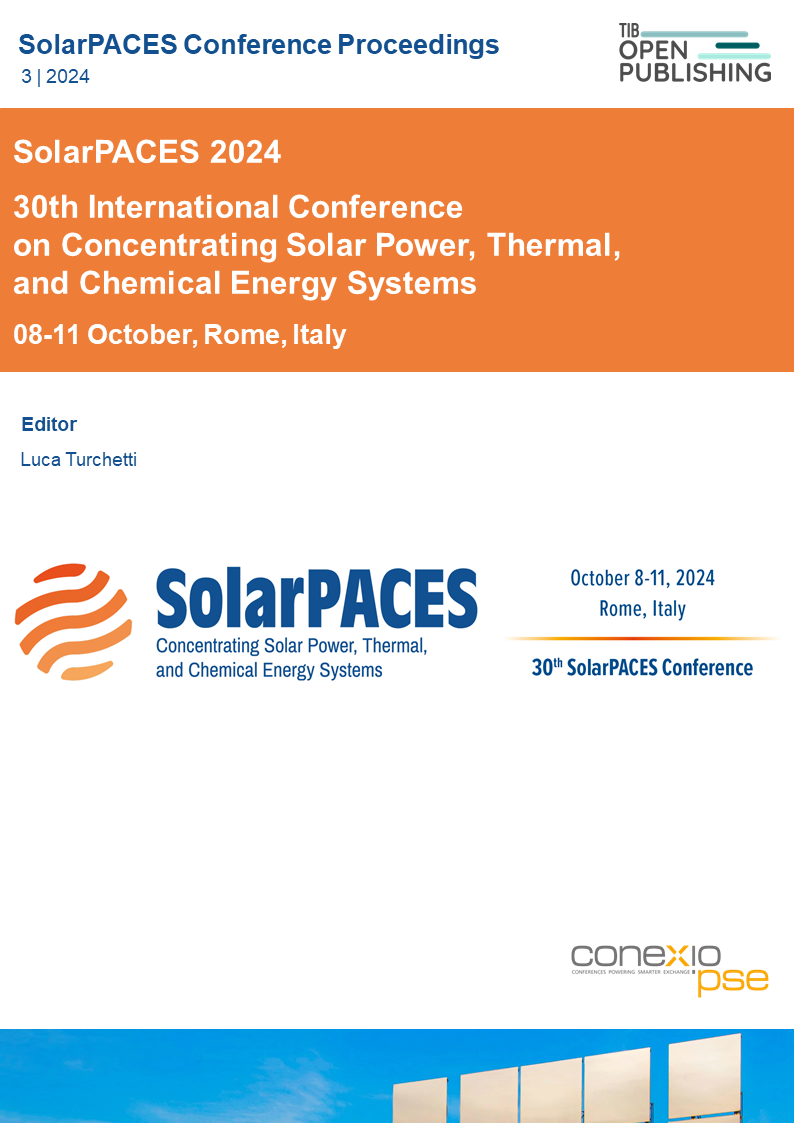Experimental Investigation of Heat Losses in Hydrogen-Doped Parabolic Trough Receivers
DOI:
https://doi.org/10.52825/solarpaces.v3i.2379Keywords:
Parabolic Trough, Solar Receiver, Heat Loss, Heat Transfer Fluid, Hydrogen FormationAbstract
This study investigates the impact of hydrogen presence in the annulus space of heat-collecting elements (HCEs) used in parabolic trough solar power plants. Hydrogen, formed during degradation of the heat transfer fluid diphenyl oxide/biphenyl (DPO/BP), can permeate into the annulus and significantly increases heat loss due to enhanced conductive heat transfer. Following the resistance heating method defined tin the technical specification IEC TS 62862-3-3, heat loss measurements were conducted on HCEs before and after hydrogen doping at various absorber temperatures (100–400 °C). Results showed heat losses up to four times higher in hydrogen-doped receivers, reaching 867 W/m at 400 °C, compared to 211 W/m in evacuated units. Uncertainty analysis confirmed measurement reliability. The data confirms hydrogen’s detrimental effect on thermal performance and supports the need for improved hydrogen control in operational solar power plants with parabolic troughs.
Downloads
References
[1] C. Jung, M. Senholdt, “Comparative study on hydrogen issues of biphenyl/diphenyl oxide polydimethylsiloxane heat transfer fluids,” AIP Conf. Proc., vol. 2303, pp. 150009, 2020, doi: 10.1063/5.0028894.
[2] K.F. Beckers, G.C. Glatzmaier, “Addressing solar power plant heat transfer fluid degrada-tion: Experimental measurements of hydrogen transport properties in binary eutectic bi-phenyl/diphenyl ether,” Sol Energy, vol.173, pp. 304-312, 2018, doi: 10.1016/j.solener.2018.07.066.
[3] F. Burkholder, M. Brandemuehl, C. Kutscher, E. Wolfrum, “Heat conduction of inert gas-hydrogen mixtures in parabolic trough receivers,” in Proceedings of ES2008, Energy Sus-tainability 2008, Jacksonville, Florida, USA, Aug., 2008.
[4] J.M. Márquez, R. López-Martín, L. Valenzuela, E. Zarza, “Test bench HEATREC for heat loss measurement on solar receiver tubes,” AIP Conf. Proc., vol. 1734, pp. 030025, 2016, doi: 10.1063/1.4949077.
[5] F. Burkholder and C. Kutscher, “Heat Loss Testing of Schott’s 2008 PTR70 Parabolic Trough Receiver,” Technical Report NREL/TP-550-45633, NREL, USA, May, 2009.
[6] E. Setien, R. López-Martín, L. Valenzuela, “Methodology for partial vacuum pressure and heat losses analysis of parabolic throughs receivers by infrared radiometry,” Infrared Physics & Technology, vol. 98, pp. 341-353, 2019, doi: 10.1016/j.infrared.2019.02.011.
[7] F. Burkholder, C. Kutscher, M. Brandemuehl, E. Wolfrum, “The Test and Prediction of Argon-Hydrogen and Xenon-Hydrogen Heat Conduction in Parabolic Trough Receivers,” in Proceedings of the SolarPACES 2011, Granada, Spain, September, 2011.
Published
How to Cite
Conference Proceedings Volume
Section
License
Copyright (c) 2025 Loreto Valenzuela, Rafael López-Martín, Carmen M. Amador-Cortés, Christoph Hilgert

This work is licensed under a Creative Commons Attribution 4.0 International License.
Accepted 2025-05-26
Published 2025-10-22
Funding data
-
Ministerio de Ciencia, Tecnología e Innovación
Grant numbers PCI2020-120704-2 -
Horizon 2020
Grant numbers 838311 -
Projektträger Jülich
Grant numbers 03EE5063A
